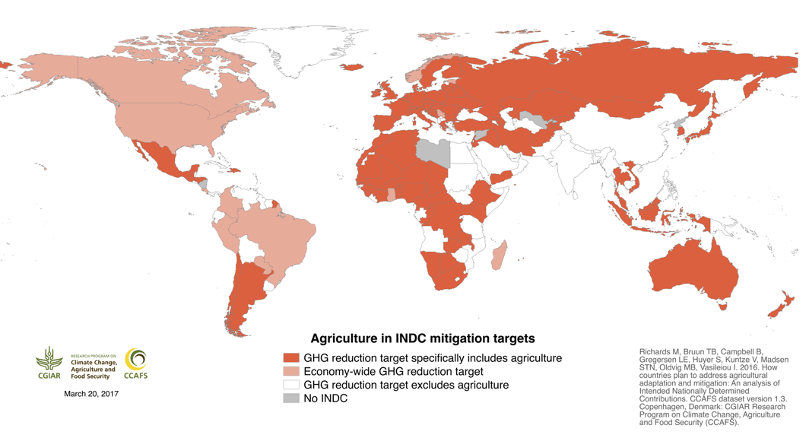Nationally determined contributions (NDCs) are bottom-up commitments toward the mitigation and adaptation goals of the Paris Agreement. Collectively, the NDCs are intended to help achieve the mitigation necessary to keep the global temperature increase below the 1.5 ° and 2 °C warming limits. Pledges include conditional targets, which require external finance, and unconditional targets financed by the country.
Countries are legally required to submit new NDCs every five years that demonstrate increased ambition and progression toward the goals of the Paris Agreement. The targets and actions within NDCs are not binding. Countries are required to report on mitigation targets and progress on the goals in their NDCs; a discussion of adaptation is not mandatory.
The UNFCCC’s registry of NDCs shows all submissions by country and date of submission. One-hundred and ninety-two (192) countries submitted an NDC in the first round. The second round of NDCs was delayed one year due to the COVID-19 pandemic but is currently underway. As of August 17, 2021, 112 countries had submitted a new or updated NDC. Additional NDCs are expected ahead of COP26 in November 2021.
Several NDC tracking tools exist, including Climate Action Tracker and Climate Watch, which can assess countries’ overall contributions. The commitments in the NDCs also can be compared to the emissions budgets estimated to be necessary to meet the Paris Agreement temperature goal (See UNEP Gap reports). The first NDCs were not sufficient to limit warming to 2 °C, so it is imperative that second-round NDCs are more ambitious to achieve the goals of the Paris Agreement.
Countries’ NDCs vary in the format, scale and detail provided in NDCs for baselines, targets and actions, making it difficult to compare countries’ commitments. For example, some countries include economy-wide emission reduction targets while others include targets for specific sectors. Efforts to improve NDC content by providing information necessary to facilitate clarity (C), transparency (T) and understanding (U), a principle known as CTU, are being promoted by groups such as the Partnership on Transparency in the Paris Agreement to enhance the quality of the NDCs.
NDCs provide an important opportunity for countries to outline their need for international support from financial institutions, development organizations, research organizations, and other implementation partners. Some organizations, such as the Green Climate Fund, seek to align their work with countries’ NDCs and can even make their assistance contingent on the NDC.
Agriculture in the NDCs
Agriculture is addressed in the NDCs either implicitly, through economy-wide goals, or explicitly with policies, measures and actions specific to the sector. Details about action in agriculture and its subsectors, such as livestock or rice, vary hugely among countries’ NDCs.
Recent studies (FAO 2016, Richards et al. 2015, Ross et al. 2019) offer the details of NDC commitments in agriculture across countries. An analysis of the first round of NDCs shows that agriculture is prominently featured for meeting mitigation and adaptation goals (Richards et al. 2016).
In the first round of NDCs, 15 UNFCCC parties included agriculture implicitly in an economy-wide GHG emissions target, 104 included agriculture in their mitigation targets, and 127 included agriculture as an adaptation priority (Richards et al. 2016). Agricultural mitigation policies and measures focused on cropland management, livestock management, and grazing land management.
None of the largest agricultural emitters included sector-specific contributions from the agriculture sector in their NDCs but rather put forward economy-wide targets.

Figure 1. Agriculture in NDC mitigation targets
NDCs do not necessarily reflect the potential of a country for the mitigation of GHG emissions. For example, relatively few countries have included explicit targets or actions related to soil carbon in agricultural or peatland soils, despite the huge mitigation potential (Wiese et al. 2021). Countries’ reasons for not including soil carbon included difficulty of monitoring and prioritization of sustainable development and food security over mitigation and a lack of incentives for farmers to improve management practices.
Countries can increase their NDCs’ mitigation ambition by setting more ambitious mitigation economy-wide targets, better understand mitigation potentials through R&D, more detailed sectoral targets, non-GHG emissions targets and by specifying policies and measures to be taken (Fransen et al. 2019).
